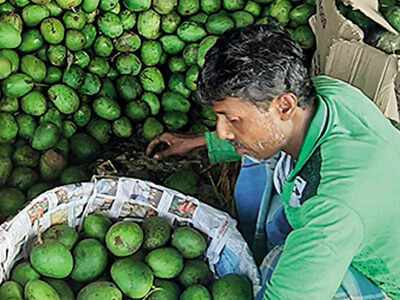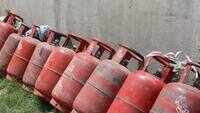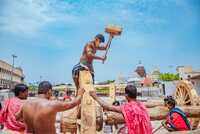
MALDA/KOLKATA: Cooped up at home, many a mango lover was waiting eagerly to bite into a slice of ripe ‘Himsagar’ to transform the sultry summer afternoon into a delightful gastronomic experience. The king of fruits that grows in rich abundance in Bengal would indeed have lifted moods during listless lockdown days had not a monster called Amphan dashed much of the hope.
The raging cyclone — whose name spelt in English ironically has a close resemblance with ‘aam’, the fruit’s name in Bengali — that devastated the state two weeks ago also plundered mango orchards in Murshidabad, Malda, Nadia, North 24 Parganas and South 24 Parganas, uprooting thousands of trees and shedding lakhs of fruits. Almost all varieties of the fruit — Himsagar, Lyangda, Begumphulli, Lakhanbhog and Fazli — were badly affected in a year that was otherwise poised to yield a bumper crop.
According to preliminary reports, the cyclone damaged an estimated 40,000 tonnes of the fruit. The projected crop of 3.5 lakh tonnes this year had already been pared to 2.5 lakh tonnes following the hailstorms that struck the districts in early summer. Post-Amphan, that figure is set to be revised to around 2 lakh tonnes.
The Mechua fruit market that is usually flooded with mango varieties in early-June is listless this year. According to traders, every year around 125-150 trucks laden with 15 tonnes of mango each roll into the market daily from mid-May. But this year, around 45 trucks are arriving every day.
“We lost a lot of business due to the lockdown and lack of labourers and were really looking forward to the mango trade. We were hoping for a turnaround as the crop was good this year and the lockdown was being eased. But then the cyclone dashed our hopes,” said Shahid Ahmed Khan, general secretary of Mechua Fruit Merchants’ Welfare Association.
The period between June 15 and July 15 is the peak mango season in Kolkata when all varieties from Bengal, UP and Bihar are simultaneously available. “We can expect around 12-14 lakh kgs of mango every day by the middle of June if inter-state movement of trucks is allowed. This will be nothing close to the supply from previous years but people will at least get to taste some varieties,” said Samir Paul, a fruit merchant on Madan Mohan Burman Street near MG Road.
Even before cyclone Amphan razed the trees and dashed hopes of a recovery after two years of poor crop, the lockdown had led to problems in sourcing labour to harvest the crop.
“Mangoes are seasonal and perishable. So there is a very small window during which the crop has to be harvested, sorted, packed and transported for sale. Since there are different varieties that ripen at different times, the activity continues from March to June. This year, the lockdown led to problems in sourcing labour and that has cost mango farmers dear,” said Uzzwal Saha, president of Malda Mango Merchant Association.
The cyclone has also affected litchie farmers with an estimated 10,000 tonnes of the fruit being damaged. The state administration believes the loss incurred by the state farm sector due to the twin-factors of Covid-19 and Amphan could scale to record levels this year.
The raging cyclone — whose name spelt in English ironically has a close resemblance with ‘aam’, the fruit’s name in Bengali — that devastated the state two weeks ago also plundered mango orchards in Murshidabad, Malda, Nadia, North 24 Parganas and South 24 Parganas, uprooting thousands of trees and shedding lakhs of fruits. Almost all varieties of the fruit — Himsagar, Lyangda, Begumphulli, Lakhanbhog and Fazli — were badly affected in a year that was otherwise poised to yield a bumper crop.
According to preliminary reports, the cyclone damaged an estimated 40,000 tonnes of the fruit. The projected crop of 3.5 lakh tonnes this year had already been pared to 2.5 lakh tonnes following the hailstorms that struck the districts in early summer. Post-Amphan, that figure is set to be revised to around 2 lakh tonnes.
The Mechua fruit market that is usually flooded with mango varieties in early-June is listless this year. According to traders, every year around 125-150 trucks laden with 15 tonnes of mango each roll into the market daily from mid-May. But this year, around 45 trucks are arriving every day.
“We lost a lot of business due to the lockdown and lack of labourers and were really looking forward to the mango trade. We were hoping for a turnaround as the crop was good this year and the lockdown was being eased. But then the cyclone dashed our hopes,” said Shahid Ahmed Khan, general secretary of Mechua Fruit Merchants’ Welfare Association.
The period between June 15 and July 15 is the peak mango season in Kolkata when all varieties from Bengal, UP and Bihar are simultaneously available. “We can expect around 12-14 lakh kgs of mango every day by the middle of June if inter-state movement of trucks is allowed. This will be nothing close to the supply from previous years but people will at least get to taste some varieties,” said Samir Paul, a fruit merchant on Madan Mohan Burman Street near MG Road.
Even before cyclone Amphan razed the trees and dashed hopes of a recovery after two years of poor crop, the lockdown had led to problems in sourcing labour to harvest the crop.
“Mangoes are seasonal and perishable. So there is a very small window during which the crop has to be harvested, sorted, packed and transported for sale. Since there are different varieties that ripen at different times, the activity continues from March to June. This year, the lockdown led to problems in sourcing labour and that has cost mango farmers dear,” said Uzzwal Saha, president of Malda Mango Merchant Association.
The cyclone has also affected litchie farmers with an estimated 10,000 tonnes of the fruit being damaged. The state administration believes the loss incurred by the state farm sector due to the twin-factors of Covid-19 and Amphan could scale to record levels this year.

Coronavirus outbreak
Trending Topics
LATEST VIDEOS
City
 Watch: Video proof of Pak diplomat spying with a decoy sent by the Indian Intelligence Agency
Watch: Video proof of Pak diplomat spying with a decoy sent by the Indian Intelligence Agency  Unlock 1.0: Non-subsidized LPG gas price hiked by Rs 11.50 in Delhi
Unlock 1.0: Non-subsidized LPG gas price hiked by Rs 11.50 in Delhi  Covid-19 crisis and lockdown: Delhi CM Arvind Kejriwal seeks public suggestions
Covid-19 crisis and lockdown: Delhi CM Arvind Kejriwal seeks public suggestions  India unlocks: Guidelines issued to taxi services operating to and from Delhi Airport
India unlocks: Guidelines issued to taxi services operating to and from Delhi Airport
More from TOI
Navbharat Times
Featured Today in Travel
Get the app





